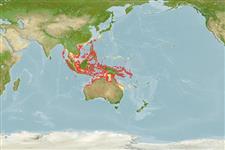分类 / Names
俗名 | 同种异名 | Catalog of Fishes(属, 种) | ITIS | CoL | WoRMS | Cloffa
Teleostei >
Acanthuriformes (Surgeonfishes) >
Pomacanthidae (Angelfishes)
Etymology: Pomacanthus: Greek, poma, -atos = cover, operculum + Greek, akantha = thorn (Ref. 45335).
More on author: Cuvier.
Environment: milieu / climate zone / depth range / distribution range
生态学
海洋 礁区鱼类; 非迁移的; 深度上下限 3 - 40 m (Ref. 9710). 热带; 32°N - 25°S, 92°E - 162°E
Indo-Pacific: Indonesia to Papua New Guinea, north to the Philippines, south to Rowley Shoals and the southern Great Barrier Reef; including Palau and Yap in Micronesia.
印度-太平洋: 印度尼西亚到巴布亚新几内亚,北至菲律宾, 南至罗雷浅滩与大堡礁的南方; 包括密克罗尼西亚的帛琉与雅普岛。
大小 / 重量 / 年龄
Maturity: Lm ? range ? - ? cm
Max length : 28.0 cm TL 雄鱼/尚未辨别雌雄; (Ref. 9710); 最大年龄: 15 年 (Ref. 72479)
背棘 (总数): 13 - 14; 背的软条 (总数): 17-18; 臀棘 3; 臀鳍软条: 18.
稚鱼侧边上黑色的有浅蓝色弯曲垂直的斑纹。 成鱼在侧面与背面,背鳍与尾鳍鳍上是鲜黄色的, 有很多的蓝色斑点; 头部与身体,胸鳍与腹鳍深蓝色的腹面部分在臀鳍与那毗连的尾柄区域的后面部分上有很多的浅蓝色斑点。 狭窄的浅蓝色条纹穿越了来自眼睛下面的面, 而且在区域上在头部正后方。 鳍边缘浅蓝色的。
Occurs in coral rich areas of clear lagoons, channels, and protected outer reef slopes. Changes to adult pattern is dramatic, and intermediate stage are rarely seen (Ref. 48636). Often solitary. Feeds on sponges and tunicates. Uncommon (Ref. 9710). Highly prized aquarium export (Ref. 37816).
出现于清澈的泻湖,峡道,与有遮蔽的外礁斜坡的珊瑚丰富的区域。 变成成鱼图案是戏剧性的,而且中间的阶段很少地被见到。 (参考文献 48636) 时常独居性的。 吃海绵与被囊类。 罕见.(参考文献 9710) 评价很高的水族馆输出。 (参考文献 37816)
Life cycle and mating behavior
成熟度 | 繁殖 | 产卵场 | 卵 | 孕卵数 | 仔鱼
印度-太平洋: 印度尼西亚到巴布亚新几内亚,北至菲律宾, 南至罗雷浅滩与大堡礁的南方; 包括密克罗尼西亚的帛琉与雅普岛。
Myers, R.F., 1991. Micronesian reef fishes. Second Ed. Coral Graphics, Barrigada, Guam. 298 p. (Ref. 1602)
人类利用
渔业: 自给性渔业; 水族馆: 商业性
更多信息
俗名同种异名新陈代谢捕食者生态毒物学繁殖成熟度产卵场产卵群集孕卵数卵卵的发育
参考文献养殖养殖信息品种遗传学Electrophoreses遗传率疾病加工NutrientsMass conversion
工具
特别资料
下载 XML
网络资源
Estimates based on models
Preferred temperature (Ref.
123201): 26.1 - 28.9, mean 27.9 °C (based on 368 cells).
Phylogenetic diversity index (Ref.
82804): PD
50 = 0.5001 [Uniqueness, from 0.5 = low to 2.0 = high].
Bayesian length-weight: a=0.03236 (0.01300 - 0.08052), b=2.89 (2.71 - 3.07), in cm total length, based on LWR estimates for this Genus-body shape (Ref.
93245).
营养阶层 (Ref.
69278): 2.7 ±0.00 se; based on food items.
回复力 (Ref.
120179): 低的, 最小族群倍增时间4.5 - 14 年 (Preliminary K or Fecundity.).
Fishing Vulnerability (Ref.
59153): Low vulnerability (18 of 100).
Nutrients (Ref.
124155): Calcium = 52.8 [27.0, 86.9] mg/100g; Iron = 0.557 [0.344, 0.909] mg/100g; Protein = 18.2 [17.0, 19.4] %; Omega3 = 0.097 [0.062, 0.153] g/100g; Selenium = 30 [17, 55] μg/100g; VitaminA = 69.3 [18.4, 250.1] μg/100g; Zinc = 1.4 [1.0, 2.0] mg/100g (wet weight);
